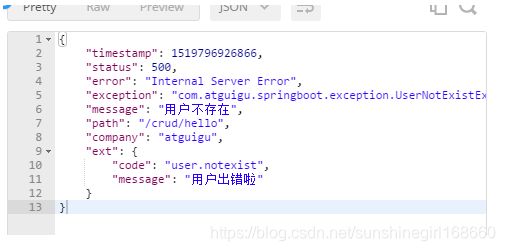Spring Boot 错误处理机制
文章目录
- 一、Spring Boot 默认的错误处理机制
- 1)针对浏览器,返回一个默认的错误页面
- 2)针对客户端,默认响应 json 数据--------------使用 PostMan 发送请求
- 二、Spring Boot 错误处理机制的原理
- 1)ErrorMvcAutoConfiguration 给容器中添加了如下组件:
- 2)执行步骤
- 三、如何定制错误响应
- 1)如何定制错误的页面
- 2)如何定制错误的 json 数据
一、Spring Boot 默认的错误处理机制
1)针对浏览器,返回一个默认的错误页面
2)针对客户端,默认响应 json 数据--------------使用 PostMan 发送请求
二、Spring Boot 错误处理机制的原理
可以参照 ErrorMvcAutoConfiguration :错误处理的自动配置
1)ErrorMvcAutoConfiguration 给容器中添加了如下组件:
1)DefaultErrorAttributes
2)BasicErrorController:处理默认的 /error 请求
@Controller
@RequestMapping({"${server.error.path:${error.path:/error}}"})
public class BasicErrorController extends AbstractErrorController {
// 返回 html 类型的数据,根据请求头 accept 属性指定,浏览器发送的请求由此方法处理
@RequestMapping(produces = {"text/html"})
public ModelAndView errorHtml(HttpServletRequest request, HttpServletResponse response) {
HttpStatus status = this.getStatus(request);
Map<String, Object> model = Collections.unmodifiableMap(this.getErrorAttributes(request, this.isIncludeStackTrace(request, MediaType.TEXT_HTML)));
response.setStatus(status.value());
// 指定去哪个错误页面,包含页面地址以及页面内容
ModelAndView modelAndView = this.resolveErrorView(request, response, status, model);
return modelAndView != null ? modelAndView : new ModelAndView("error", model);
}
// 返回 json 格式的数据,根据请求头 accept 属性指定,其他客户端发送的请求由此方法处理
@RequestMapping
@ResponseBody
public ResponseEntity<Map<String, Object>> error(HttpServletRequest request) {
Map<String, Object> body = this.getErrorAttributes(request, this.isIncludeStackTrace(request, MediaType.ALL));
HttpStatus status = this.getStatus(request);
return new ResponseEntity(body, status);
}
}
3)ErrorPageCustomizer

4)DefaultErrorViewResolver
@Override
public ModelAndView resolveErrorView(HttpServletRequest request, HttpStatus status,
Map<String, Object> model) {
ModelAndView modelAndView = resolve(String.valueOf(status), model);
if (modelAndView == null && SERIES_VIEWS.containsKey(status.series())) {
modelAndView = resolve(SERIES_VIEWS.get(status.series()), model);
}
return modelAndView;
}
private ModelAndView resolve(String viewName, Map<String, Object> model) {
//默认 SpringBoot 可以去找到一个页面? error/404(状态码)
String errorViewName = "error/" + viewName;
//模板引擎可以解析这个页面地址就用模板引擎解析
TemplateAvailabilityProvider provider = this.templateAvailabilityProviders
.getProvider(errorViewName, this.applicationContext);
if (provider != null) {
//模板引擎可用的情况下返回到 errorViewName 指定的视图地址
return new ModelAndView(errorViewName, model);
}
//模板引擎不可用,就在静态资源文件夹下找 errorViewName 对应的页面 error/404.html
return resolveResource(errorViewName, model);
}
2)执行步骤
一旦系统出现4xx或5xx之类的错误,ErrorPageCustomizer 就会生效(定制错误的响应规则),就会来到 /error 请求,由 BasicErrorController 来处理 /error 请求,就会被 BasicErrorController 进行处理
1)响应页面:去哪个页面是由 DefaultErrorViewResolver 解析得到的
public abstract class AbstractErrorController implements ErrorController {
protected ModelAndView resolveErrorView(HttpServletRequest request, HttpServletResponse response, HttpStatus status, Map<String, Object> model) {
Iterator var5 = this.errorViewResolvers.iterator();
ModelAndView modelAndView;
do {
if (!var5.hasNext()) {
return null;
}
// 所有的 ErrorViewResolver 得到 ModelAndView
ErrorViewResolver resolver = (ErrorViewResolver)var5.next();
modelAndView = resolver.resolveErrorView(request, status, model);
} while(modelAndView == null);
return modelAndView;
}
}
三、如何定制错误响应
1)如何定制错误的页面
1)有模板引擎的情况下:error/状态码;【将错误页面命名为 错误状态码.html 放在模板引擎文件夹里面的 error文件夹下】,发生此状态码的错误就会来到 对应的页面;
我们可以使用4xx和5xx作为错误页面的文件名来匹配这种类型的所有错误,精确优先(优先寻找精确的状态码.html);
页面能获取的信息;
timestamp:时间戳
status:状态码
error:错误提示
exception:异常对象
message:异常消息
errors:JSR303数据校验的错误都在这里
2)、没有模板引擎(模板引擎找不到这个错误页面),静态资源文件夹下找;
3)、以上都没有错误页面,就是默认来到SpringBoot默认的错误提示页面;
2)如何定制错误的 json 数据
1)、自定义异常处理&返回定制json数据;
@ControllerAdvice
public class MyExceptionHandler {
@ResponseBody
@ExceptionHandler(UserNotExistException.class)
public Map<String,Object> handleException(Exception e){
Map<String,Object> map = new HashMap<>();
map.put("code","user.notexist");
map.put("message",e.getMessage());
return map;
}
}
//没有自适应效果...
2)、转发到/error进行自适应响应效果处理
@ExceptionHandler(UserNotExistException.class)
public String handleException(Exception e, HttpServletRequest request){
Map<String,Object> map = new HashMap<>();
//传入我们自己的错误状态码 4xx 5xx,否则就不会进入定制错误页面的解析流程
/**
* Integer statusCode = (Integer) request
.getAttribute("javax.servlet.error.status_code");
*/
request.setAttribute("javax.servlet.error.status_code",500);
map.put("code","user.notexist");
map.put("message",e.getMessage());
//转发到/error
return "forward:/error";
}
3)将我们定制的错误信息携带出去
出现错误以后,会来到 /error 请求,会被 BasicErrorController 处理,响应出去可以获取的数据是由 getErrorAttributes 得到的(是 AbstractErrorController(ErrorController)规定的方法);
1、完全来编写一个 ErrorController 的实现类【或者是编写 AbstractErrorController 的子类】,放在容器中;
2、页面上能用的数据,或者是 json 返回能用的数据都是通过 errorAttributes.getErrorAttributes 得到;
容器中 DefaultErrorAttributes.getErrorAttributes();默认进行数据处理的;
自定义ErrorAttributes
//给容器中加入我们自己定义的ErrorAttributes
@Component
public class MyErrorAttributes extends DefaultErrorAttributes {
@Override
public Map<String, Object> getErrorAttributes(RequestAttributes requestAttributes, boolean includeStackTrace) {
Map<String, Object> map = super.getErrorAttributes(requestAttributes, includeStackTrace);
map.put("company","atguigu");
return map;
}
}




